Bibliometric Study of Obesity Research in Canada, 1998-2007
Table of contents
- Methods
- 1.1 Database
- 1.2 Indicators
- 1.3 Statistical Test
- 1.4 Publications Files Reconstitution
- 1.4.1 Automatic Matching
- 1.4.2 Manual Validation
- The Core of Obesity Research
- Obesity Research in the Periphery
- 3.1 Number of Publications
- 3.2 Scientific Impact
- 3.3 Specialization
- Conclusion
- Bibliography
- Appendix 1. Selected Canadian and other Clinical Journals
- Appendix 2. Journals by Subfield
Figures
- Figure 1 - Number of Publications in Obesity (Core) for the World, G7 Countries and the U.S., 1998-2007
- Figure 2 - Number of Publications in Obesity (Core) for Specific Countries and CIHR-Funded Obesity Researchers, 1998-2007
- Figure 3 - Share of CIHR-Funded Papers in Canadian Obesity Papers (Core), 1998-2007
- Figure 4 - Share of Canadian Papers in G7 Obesity Papers (Core), 1998-2007
- Figure 5 - Share of Obesity Papers (Core) in CIHR-Funded Researchers’ Papers, 1998-2007
- Figure 6 - Average of Relative Impact Factor (ARIF) and Average of Relative Citations (ARC) for CIHR and Canadian Obesity Papers (Core), 1998-2007
- Figure 7 - Percentage of International Collaboration of Obesity Publications (Core) for the World, G7 Countries and CIHR, 1998-2007
- Figure 8 - Canadian Inter-Institutional Collaboration Network in Obesity Research (Core), Including Foreign Institutions (5 collaborations or more), 1998-2007
- Figure 9 - CIHR-Funded Researchers’ Inter-Intitutional Collaboration in Obesity Research (Core), Including Foreign Institutions (5 collaborations or more) , 1998-2007
- Figure 10 - Specialization Index and Average Relative Citations (ARC) for G7 Countries and CIHR in Obesity Research (Core), 1998-2007
- Figure 11 - Number of Obesity Papers of CIHR and Canadian Researchers in a Sample of Canadian and Clinical Journals, 1998-2007
- Figure 12 - Share of Obesity Papers of CIHR in Canadian Research in a Sample of Canadian and Clinical Journals, 1998-2007
- Figure 13 - Average of relative citations (ARC) of Obesity Papers of CIHR and Canadian Researchers in a Sample of Canadian and Clinical Journals, 1998-2007
- Figure 14 - Average of relative impact factor (ARIF) of Obesity Papers of CIHR and Canadian Researchers in a Sample of Canadian and Clinical Journals, 1998-2007
- Figure 15 - Number of Publications in Obesity (Periphery) for the World, G7 Countries and the U.S., 1998-2007
- Figure 16 - Number of Publications in Obesity (Periphery) for Specific Countries and CIHR-Funded Researchers, 1998-2007
- Figure 17 - Share of CIHR-Funded Papers in Canadian Obesity Papers (Periphery), 1998-2007
- Figure 18 - Share of Canadian Papers in G7 Obesity Papers (Periphery), 1998-2007
Tables
- Table 1 - Journals and Keywords Used for the Core Definition of Obesity Research
- Table 2 - Number of Publications in Obesity (Core) for the World, G7 Countries and CIHR-Funded Obesity Researchers 1998-2007
- Table 3 - Average of Relative Impact Factor (ARIF) and Average of Relative Citations (ARC) for the World, G7 Countries and CIHR (Core Obesity Papers), 1998-2007
- Table 4 - Number of Obesity Papers of CIHR and Canadian Researchers in a Sample of Canadian and Clinical Journals, 1998-2007
- Table 5 - Number of Publications in Obesity (Periphery) for the World, G7 Countries and CIHR-Funded Researchers, 1998-2007
- Table 6 - Average of Relative Citations (ARC) and Average of Relative Impact Factor (ARIF) of Countries in Obesity Research (Periphery), by Subfield, 1998-2007
- Table 7 - Specialization Index and Number of Obesity Papers (Periphery) of Countries, by Subfield, 1998-2007
Introduction
It is estimated that 1.7 billion people worldwide are either overweight (defined by a body mass index [BMI] = 25) or obese (BMI = 30) (Jamieson, 2003). In the United States (U.S.), obesity has risen from 16% in 1995 to more than 26% in 2007. Only 37% of people living in the U.S. can be classified currently as neither overweight nor obese1 (U.S. Centers for Disease Control and Prevention, 2009). In the early 1970s, approximately 7% of Canadians (Torrance et al., 2002) were obese. By 2004, nearly a quarter of the population fell into this category (Starky, 2005). The numbers in Europe and elsewhere are hardly more promising. In France, for example, 17% of the population are now obese, 21 % in Germany, 38% in Lebanon, and 35% in Saudi Arabia (International Association for the Study of Obesity, 2008).
These alarming trends have garnered the problem intense scrutiny at both national and international levels. A 1997 World Health Organization report framed the threat as a global epidemic, inventing, inter alia, the neologism "globesity". The report concluded rather gloomily that
"without societal changes, a substantial and steadily rising proportion of adults will succumb to the medical complications of obesity; indeed, the medical burden of obesity already threatens to overwhelm health services. The spectrum of problems seen in both developing and developed countries is having so negative an impact that obesity should be regarded as today's principal neglected public health problem." (World Health Organization, 1997. p.2)
Recognition of the problem has evolved significantly. When the National Institutes of Health (NIH) convened a Consensus Development Conference on the Health Implications of Obesity in 1985, the primary conclusion they reached was that the "evidence is now overwhelming that obesity, defined as excessive storage of energy in the form of fat, has adverse effects on health and longevity" (NIH, 1985). The cautious nature of the conclusion clearly indicates how truly recent the recognition of obesity as a dire medical problem has been. The same panel nonetheless had the perspicacity to recognize the interdisciplinary nature of the problem noting that "it is almost certain that obesity has multiple causes and that there are different types of obesity" (NIH, 1985). While the division of obesity into types may be necessary for the purposes of obesity research, the biopsychosocial aspect of the condition also justifies the conception of an "obesity research continuum" that ranges from measurement, genetics and metabolism to epidemiology, public policy, surgery and prevention (Bouchard, 2008).
In Canada, obesity has been the strategic focus of the Canadian Institutes of Health Research (CIHR) Institute of Nutrition Metabolism and Diabetes (INMD) since 20012. The dedicated focus on a single strategic priority for nearly eight years, together with the increased emphasis on demonstrating the benefits of health research has motivated CIHR Impact Assessments unit to evaluate the overall impact of CIHR's Obesity Healthy Body Weight initiative and obesity research to date. In this context, bibliometric data can help us understand the importance of such research in Canada as well as its scientific impact.
This report analyses worldwide trends in obesity research, with a special focus on CIHR-funded researchers in the area of obesity (N=303) and Canadian researchers. The 303 CIHR-funded researchers were Principal Investigators whose CIHR grants were identified as obesity related and ended between 2001 and 2007. A decision was taken to limit the set of researchers to those who had the best chance of having published, namely the researchers whose grants had ended by 2007. This decision reduced the number of researchers in our set and may have eliminated researchers who are publishing before the end of their grant. The last group of researchers would then be associated with the "Canadian Researchers" group, just as the researchers who may have been funded by CIHR for topics that are not identified as relating directly to obesity but still published on obesity. In other words, we believe that our way of selecting researchers created a bias that is conducive to the underestimation of the number of obesity researchers funded by CIHR and of the number of their publications. Section 1 presents the methods used in the report. Then, two main analyses are provided. The first part examines the core research in obesity, using a narrow definition of obesity based on keywords found in titles and author keywords of papers as well as a list of obesity journals. The second part uses a broader definition of obesity, with the same obesity keywords searched in the abstracts of papers published in four subfields: endocrinology (diabetes), cardiovascular health, nutrition and dietetics, and gastroenterology (including hepatology).
1 Methods
1.1 Database
The bibliometric data presented here are from the Canadian Bibliometric Database (CBDTM) built by the Observatoire des sciences et des technologies (OST) using Thomson Reuters' Web of Science (WoS). The WoS includes three databases: the Science Citation Index ExpandedTM, the Social Sciences Citation IndexTM, and the Arts & Humanities Citation IndexTM, covering more than 9,000 journals in all fields of science. As such, the statistics presented here do not include all documents likely to have been published by Canadian or foreign researchers, since some works are disseminated through other scientific media not indexed by the WoS (e.g., highly specialized journals, national journals, grey literature and particularly conference proceedings not published in journals). What these statistics do measure, however, are publications that are the most visible internationally and therefore the most visible to Canadian and worldwide scientific communities. Moreover, these statistics refer to the share of scientific output that is most likely to be cited.
Although OST's database includes several types of documents, only articles, research notes and review papers are typically selected in producing bibliometric studies as these are the primary means of disseminating new knowledge. The OST's database uses a discipline classification developed by CHI Research and used by the National Science Foundation (NSF) in the U.S. The primary advantage of this classification over the one provided by the WoS is that it categorizes each journal exclusively within a single discipline, which prevents duplicate-counting when the data are presented by discipline.
Unfortunately, neither the NSF nor the WoS disciplinary classifications have a category for obesity. Hence, the first challenge of this study was to circumscribe obesity research using a set of keywords and journals. After the analysis of the publication files of CIHR-funded researchers in the area of obesity (see section 1.4 for details), a list of obesity keywords and obesity journals was selected in collaboration with CIHR (Table 1). In order to measure the core of the research in obesity—that is, papers in which obesity is the main focus and not a secondary aspect—these keywords were searched in the title and author keyword fields of OST's database. The papers retrieved using this strategy, in addition to all the papers published in eight obesity journals, form the dataset of core obesity papers analysed in Section 2 of this report. This analysis also includes obesity related papers found in a selected list of Canadian and clinical journals chosen by CIHR (see Appendix 1).
Table 1 - Journals and Keywords Used for the Core Definition of Obesity Research
| Journals | Keywords |
|---|---|
|
|
The second analysis (obesity research in the periphery) is based on a broader definition of obesity. Obesity keywords (Table 1) are searched in the abstract field of papers. In order to minimize the amount of false positives, this analysis is limited to the fields of endocrinology (diabetes), cardiovascular system, nutrition & dietetics and gastroenterology (including hepatology). The list of journals of each subfield can be found in Appendix 2. This dataset is analysed in Section 3. These analyses compare papers authored by CIHR-funded researchers and Canadian papers to papers authored by researchers from G7 countries3.
1.2 Indicators
Number of publications: The number of scientific papers authored by researchers funded by the CIHR (based on authors' names) or authored by researchers from G7 countries (based on authors' addresses). These numbers are based on "whole" counting of scientific papers, which means that one paper is attributed to an entity when at least one of the authors is from this entity, irrespective of their rank in the authors' order.
Average of relative citations (ARC): The number of citations received by papers over a three-year period following publication year. For example, for papers published in 2000, citations received between 2000 and 2003 are counted. The last year available in OST's database is 2007, which means that citation counts for papers published between 2005 and 2007 are incomplete. These citations are normalized by the average number of citations received by papers in the same subfield, hence taking into account the fact that citations practices are different for each subfield. When the ARC is above 1, it means that a group of researchers scores better than the world average; when it is below 1, the group of researchers is not cited as often as the world average.
Average relative impact factor (ARIF): A proxy for the quality of the journals in which a group or researchers publish. Each journal has an impact factor (IF), which is calculated annually by Thomson Scientific based on the number of citations received by a journal relative to the number of papers it published. The IF of papers is calculated by ascribing to them the IF of the journals in which they are published. In order to account for different citation patterns across fields and subfields of science (e.g., to adjust for the higher number of citations in biomedical research than mathematics), each paper's IF is then divided by the average IF of the papers in its subfield to obtain a relative impact factor (RIF). The ARIF of a given group of researchers is computed using the average RIF of each paper published by that group. When the ARIF is above 1, it means that this group of researchers scored better than the world average; when it is below 1, the group publishes in journals that are not cited as often as the world average.
Specialization index (SI): The intensity of research of a group of researchers in a given research area (i.e., a field or subfield) relative to the intensity of the reference group (usually the world) in the same research area. An SI value above 1 means that a given group or researchers is specialized in a given research area relative to the reference group, while an index value below 1 means that it is not specialized.
International collaboration rate: The relative intensity of scientific collaboration between countries is calculated by dividing the number of papers of a given country with at least one foreign address by the total number of papers of the said country.
1.3 Statistical Test
In order to assess if the observed differences between the scientific impact of CIHR-funded and G7 papers, a series of statistical tests were performed using Statistical Package for the Social Sciences (SPSS v.16.). Given that data on publications and citations are not normally distributed—a minority of highly productive researchers account for the majority of the papers, and a minority of papers account for the majority of citations— a non-parametric statistical test, the Mann-Whitney U (Mann and Whitney, 1947) was used.
1.4 Publications Files Reconstitution
As a research council, CIHR does not appear within the author's addresses found on scientific papers. Hence, in order to compile bibliometric statistics on research funded by the CIHR, one has to reconstitute the list of publications of CIHR-funded researchers. This involved a two-part process. First, the automatic matching of names contained in the list of CIHR-funded researchers was done against authors names contained in the bibliometric database. Second, in order to avoid overestimates created by namesakes, we performed a manual cleaning of each researcher's file.
1.4.1 Automatic Matching
Before the automatic matching occurs, we transformed all names contained in the list of CIHR-funded researchers (N=303) according to the form of authors' names in the bibliometric database, since authors' names in the bibliometric database do not include the authors' first names but only his or her initial(s). For example, "John W. Smith" is transformed into "Smith-JW" and also into "Smith-J", to ensure publications for which the middle name (or initial) has been omitted are not overlooked. Then, we run a search which retrieves, using each researcher's transformed name, all papers published between 1998 and 2007.
It is important to note that this crude matching generates over-estimates in the number of publications, and especially for researchers with common surnames due to the following limitation do the WoS indexing:
- It only includes the initial of the first name. John Smith, James Smith and Joan Smith are all identified as "Smith-J"
- It does not contain any information on the relation between the names of the authors and their institutional affiliation (e.g., University of Alberta, McGill University, McMaster University, Harvard University). Thus, for a given paper signed by John, Jack and Paul and on which McGill, Harvard and Alberta universities appear, it is impossible to identify each researcher's institutional affiliation, as there are several possible combinations. The namesakes issue is therefore not limited to researchers located in the same institution, but also extends to all collaborators from all institutions around the world.
Using a sample of cleaned publication files of researchers from the Province of Québec universities, we recently did an estimation of the extent of the namesake problem (N = 9,273). It showed that:
- 4,156 researchers (44.8%) had no overestimation (no homonyms);
- 518 researchers (5.6%) had their production overestimated between 1% and 24.9%;
- 517 researchers (5.6%) had their production overestimated between 25% and 49.9%;
- 702 researchers (7.6%) had their production overestimated between 50% and 74.9%;
- 863 researchers (9.3%) had their production overestimated between 75% and 99.9%;
- 2,517 researchers (27.1%) had an overestimation of 100% which, in turn, meant that they had no papers (all papers were written by homonyms, i.e., authors with the same surname and initials).
An automatic matching is therefore valid for approximately 45% of the researchers. This leaves a remaining 55% of researchers with a significant overestimate of their scientific production. Since we cannot know a priori which researchers will be overestimated and which will not, we need to manually validate each paper from each researcher.
1.4.2 Manual Validation
Cleaning the publications files consists of removing the publications wrongly assigned to a researcher by the automatic matching procedure (described above). In other words, it aims at correcting the overestimates that result from the automatic matching. To do that, we look closely and carefully at all papers contained in each publication list with special attention to their disciplines and their particular topics. Are the publications consistent with respect to the researcher's discipline as indicated by his or her departmental affiliation? Are the publications of a larger scope than one would expect of an individual researcher? For example, we would question seriously the attribution of an engineering paper to a health researcher, or a paper in physics to a sociologist. However, it should also be noted that we cannot rely mechanically on the departmental affiliation of a researcher to validate the publications of his or her file, as for example, a medical researcher might publish articles about medical ethics in philosophy journals.
2. The Core Of Obesity Research
This section of the report analyzes publication, impact and collaboration trends in obesity research using the definition of the core of obesity research presented in section 1.1.
2.1 Number of Publications
Figure 1, Figure 2, and Table 2 present worldwide trends in obesity research. They show that the worldwide number of obesity papers increased steadily since 1998, going from 4,000 papers to more than 11,000 over the 10-year period. Canada ranks seventh for the whole period, but third in 2007, due to a sharp increase of its production after 2003. The number of papers written by CIHR-funded researchers also increases constantly from 1998 to 2007. More precisely, papers authored by CIHR-funded researchers in the area of obesity increased by more 400%; passing from 37 in 1998 to 163 in 2007. As in most areas of science, the U.S. is the world's largest producer of obesity papers, followed by the United Kingdom, Japan and France (Figure 2).
Figure 1 - Number of Publications in Obesity (Core) for the World, G7 Countries and the U.S., 1998-2007
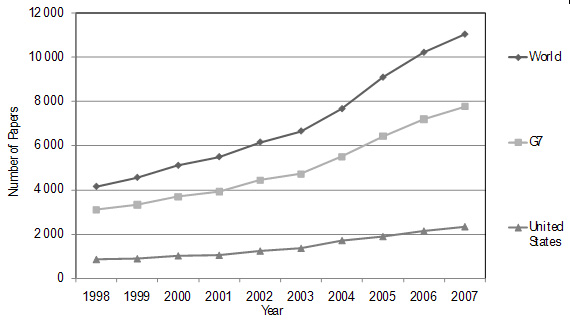
Source: Observatoire des sciences et des technologies, WoS Database
Figure 2 - Number of Publications in Obesity (Core) for Specific Countries and CIHR-Funded Obesity Researchers, 1998-2007
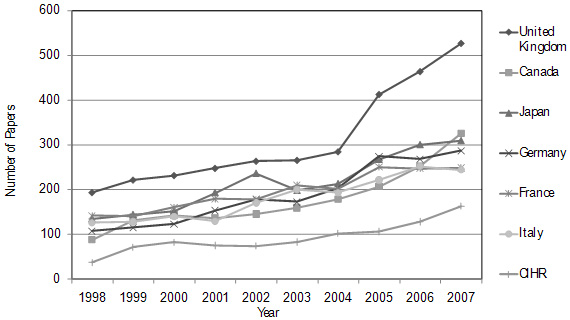
Source: Observatoire des sciences et des technologies, WoS Database
Table 2 - Number of Publications in Obesity (Core) for the World, G7 Countries and CIHR-Funded Obesity Researchers 1998-2007
| Country | 1998 | 1999 | 2000 | 2001 | 2002 | 2003 | 2004 | 2005 | 2006 | 2007 |
|---|---|---|---|---|---|---|---|---|---|---|
| Canada | 88 | 132 | 143 | 136 | 145 | 159 | 178 | 206 | 252 | 325 |
| CIHR | 37 | 71 | 82 | 75 | 74 | 83 | 102 | 106 | 128 | 163 |
| France | 141 | 140 | 160 | 179 | 177 | 209 | 201 | 250 | 247 | 248 |
| Germany | 107 | 115 | 122 | 153 | 178 | 172 | 203 | 274 | 268 | 287 |
| Italy | 126 | 128 | 140 | 129 | 170 | 200 | 193 | 222 | 252 | 244 |
| Japan | 135 | 144 | 152 | 193 | 236 | 198 | 213 | 267 | 300 | 309 |
| United Kingdom | 193 | 221 | 231 | 247 | 263 | 265 | 284 | 412 | 463 | 526 |
| United States | 860 | 896 | 1,023 | 1,049 | 1,239 | 1,357 | 1,704 | 1,886 | 2,131 | 2,327 |
| G7 | 3,100 | 3,330 | 3,680 | 3,916 | 4,437 | 4,714 | 5,504 | 6,421 | 7,189 | 7,765 |
| World | 4,152 | 4,560 | 5,106 | 5,496 | 6,162 | 6,662 | 7,672 | 9,102 | 10,228 | 11,048 |
Source: Observatoire des sciences et des technologies, WoS Database
Figure 3 and Figure 4 present, for the field of obesity, the share of CIHR-funded obesity papers within the total number of Canadian obesity papers as well as the share of Canadian papers within the total number of G7 obesity papers. With a total of 921 Canadian papers between 1998 and 2007, CIHR is the most important research network on obesity in Canada, accounting for 52%. There are, however, variations in this percentage over this period (Figure 3), with lows in 1998 (42%), 2002 (51%) and 2007 (50%), and peaks in 2000 and 2004 at 57%. After decreasing between 1999 and 2005, the share of obesity papers authored by Canadian researchers rises at the end of the period and accounts for more than 4% of G7 papers in 2007. Given that CIHR papers account for about 50% of Canadian publications in obesity field, this means that CIHR-funded obesity papers account for 2% of the total number of G7 obesity papers.
Figure 3 - Share of CIHR-Funded Papers in Canadian Obesity Papers (Core), 1998-2007
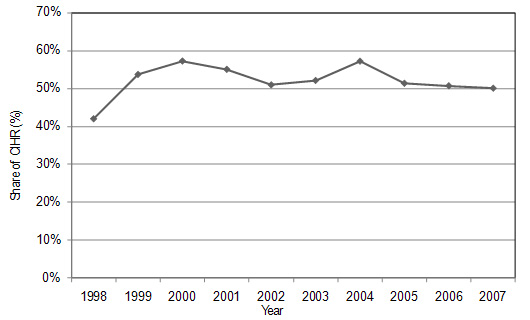
Source: Observatoire des sciences et des technologies, WoS Database
Figure 4 - Share of Canadian Papers in G7 Obesity Papers (Core), 1998-2007
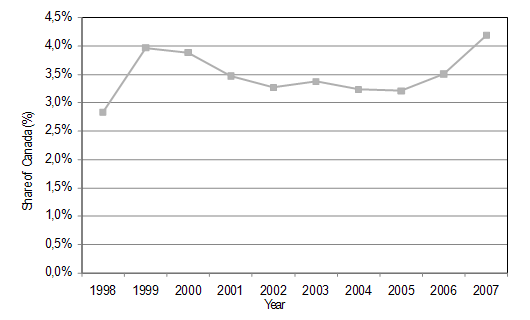
Source: Observatoire des sciences et des technologies, WoS Database
Figure 5 presents the percentage of core obesity papers among all papers authored by CIHR researchers. This percentage increased from 10.4% in 2001 to 17.5% in 2007, which suggest that CIHR is increasingly funding researchers for whom obesity is the main research topic.
Figure 5 - Share of Obesity Papers (Core) in CIHR-Funded Researchers' Papers, 1998-2007
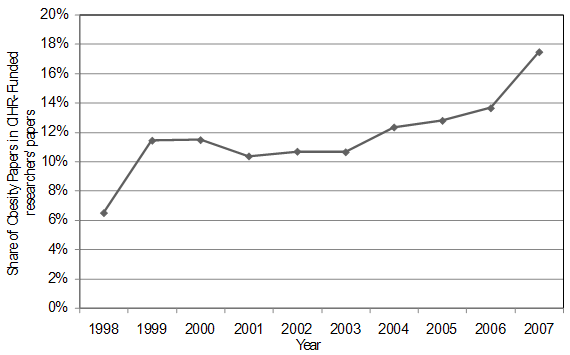
Source: Observatoire des sciences et des technologies, WoS Database
2.2 Scientific Impact
Scientific impact is assessed using two metrics: the average of relative impact factor (ARIF) and the average of relative citations (ARC). Figure 6 compares the ARC of CIHR papers with that of non CIHR-funded Canadian papers (i.e., excluding those authored by CIHR-funded researchers). It shows that the impact of non-CIHR Canadian papers is (slightly) above that of CIHR papers only in 2004 and 2006 and well below for all other years. As stated before, the ARC of Canadian non-CIHR papers is indeed significantly lower (p. < 0.05) than that of CIHR papers for the whole period.
Figure 6 - Average of Relative Impact Factor (ARIF) and Average of Relative Citations (ARC) for CIHR and Canadian Obesity Papers (Core), 1998-2007
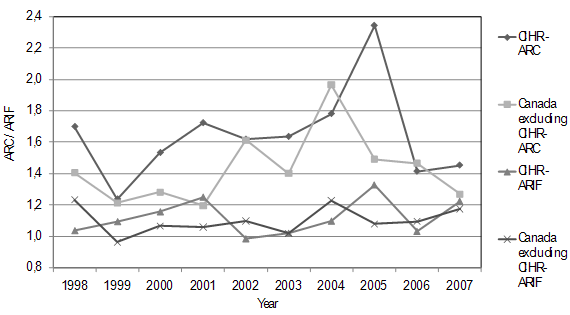
Source: Observatoire des sciences et des technologies, WoS Database
Table 3 presents values of ARC and ARIF of countries over the two 5-year periods covered by this report, as well as for the total 10-year span. One might observe that world averages are higher than 1; this is due to the fact that articles in obesity are, on average, published in journals with higher impact factors and receive more citations than average journals or papers published in the same subfield.Table 3 also shows that, except for the U.S., all countries are improving their ARIF in obesity. On both measures, Canada is on a par with the G7 as a whole. Canada's ARIF score is below that of the U.S., on a par with the U.K., and above all other countries. With regard to the ARC, Canada is below the U.S. and the U.K., but above that of all other countries. In absolute terms, Canada's score improved for both indexes between the two 5-year periods.
On another scale, CIHR's ARIF values are quite the same as that of Canadian papers—even when one excludes CIHR-funded papers from the Canadian total—but its ARC is higher than the Canadian average. Given that CIHR papers account for more than 50% of Canadian papers, this means that papers published by researchers not funded by CIHR have a considerably lower scientific impact. At 1.43 for the 10-year period, the ARC of non-CIHR Canadian papers is indeed significantly lower (p. < 0.05) than that of CIHR papers (1.64). Finally, in comparison with the G7 as a whole, CIHR papers obtain higher ARC (p. < 0.05) and ARIF (p. < 0.05).
Table 3 - Average of Relative Impact Factor (ARIF) and Average of Relative Citations (ARC) for the World, G7 Countries and CIHR (Core Obesity Papers), 1998-2007
| Country | 1998-2002 | 2002-2007 | 1998-2007 | |||
|---|---|---|---|---|---|---|
| ARIF | ARC | ARIF | ARC | ARIF | ARC | |
| Canada | 1.10 | 1.46 | 1.14 | 1.59 | 1.12 | 1.54 |
| CIHR | 1.12 | 1.55 | 1.15 | 1.69 | 1.14 | 1.64 |
| Other Canada |
1.08 | 1.35 | 1.13 | 1.47 | 1.11 | 1.43 |
| France | 0.99 | 1.37 | 1.03 | 1.38 | 1.01 | 1.37 |
| Germany | 0.87 | 1.22 | 0.92 | 1.34 | 0.90 | 1.30 |
| Italy | 0.91 | 1.11 | 1.02 | 1.26 | 0.98 | 1.20 |
| Japan | 0.86 | 1.16 | 0.93 | 1.02 | 0.91 | 1.07 |
| United Kingdom | 1.01 | 1.42 | 1.17 | 1.78 | 1.11 | 1.64 |
| United States | 1.25 | 1.83 | 1.21 | 1.77 | 1.22 | 1.79 |
| G7 | 1.09 | 1.53 | 1.12 | 1.56 | 1.11 | 1.55 |
| World | 1.02 | 1.38 | 1.05 | 1.39 | 1.04 | 1.39 |
Source: Observatoire des sciences et des technologies, WoS Database
2.3 Collaboration
2.3.1 International Collaboration
Figure 7 presents the percentage of international collaboration for G7 Countries and CIHR papers. It shows that CIHR's percentage of international collaboration is higher than that of all G7 countries between 1999 and 2006. However, this percentage decreased starting in 2005 and, in 2007, CIHR dropped below all G7 countries except Japan and the U.S. On the other hand, international collaboration rates have increased steadily in all countries except Japan and Canada. One should note finally that collaboration on obesity research in general is slightly less common than in scientific research in general (that is, in all fields combined). For example, in 2007, 42% of Canadian papers on obesity were written in with foreign co-authors, whereas for all field combined this percentage is 45%.
Figure 7 - Percentage of International Collaboration of Obesity Publications (Core) for the World, G7 Countries and CIHR, 1998-2007
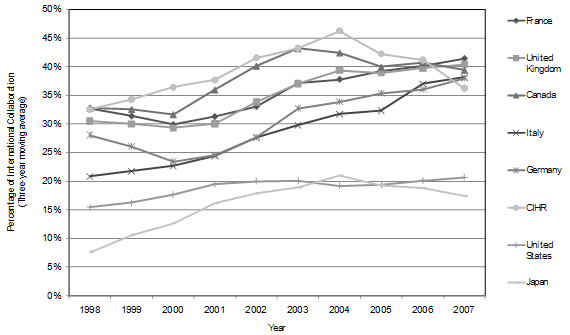
Source: Observatoire des sciences et des technologies, WoS Database
2.3.2 Inter-institutional Collaboration
Figure 8 is made using Netdraw (Borgatti, 2002) and UCINET (Borgatti, Everett & Freeman, 2002) software and presents the network of collaboration between Canadian institutions active in obesity research. The size of the lines between institutions reflects the intensity of the collaboration and the size of each node (representing institutions) is a function of their centrality (importance) in the network. Inter-institutional collaboration is measured using cosignatures: an article is considered as the result of inter-institutional collaboration if it contains at least two addresses from two different institutions.
This figure demonstrates that Canadian obesity research has two main clusters. The largest one includes institutions mostly from the Province of Québec, with some others from eastern and southern Ontario. The central nodes of this cluster are Université Laval and, to a lesser extent, Université de Montréal and McGill University. The second cluster revolves around the University of Toronto and McMaster University. Almost all institutions included in this cluster are located in southern and western Ontario or in the Prairie provinces. Collaborations with foreign institutions are less frequent for this cluster and collaboration ties are less strong. It is also interesting to note that Queen's University is the only link between these two clusters. Finally, a smaller cluster regroups institutions from British Columbia and Newfoundland. As shown for all fields in the sciences (Larivière, Gingras and Archambault, 2006), Canadian patterns of collaboration are influenced by geographical proximity and language. Thus, it is not surprising to see that institutions from Québec collaborate more intensely with each other and that they are the only ones to collaborate with French partners.
Figure 8 - Canadian Inter-Institutional Collaboration Network in Obesity Research (Core), Including Foreign Institutions (5 collaborations or more), 1998-2007
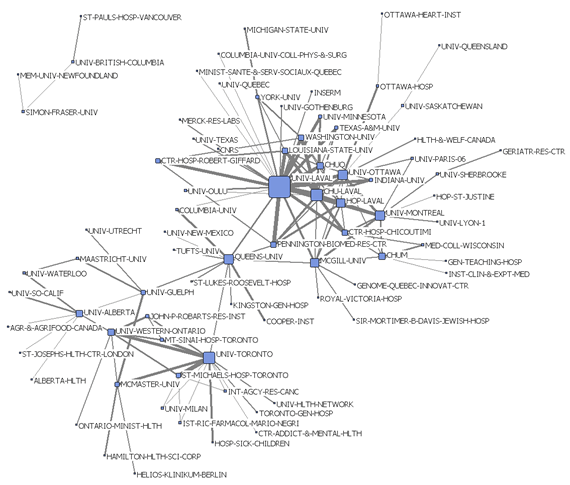
Source: Observatoire des sciences et des technologies, WoS Database
Figure 9 shows inter-institutional collaborations for the subset of CIHR-funded papers for institutions having at least 3 papers in inter-institutional collaboration. Unsurprisingly, it follows a pattern similar to that of Canadian research as a whole: there are two main clusters linked to each other only by Queen's University, with the Université Laval being the central node of the main cluster. McGill University, Université de Montréal and University of Ottawa are also important institutions in this cluster. The second cluster is grouped around the University of Toronto and includes only the University of Western Ontario, McMaster University and others central and western institutions.
Figure 9 - CIHR-Funded Researchers' Inter-Intitutional Collaboration in Obesity Research (Core), Including Foreign Institutions (5 collaborations or more) , 1998-2007
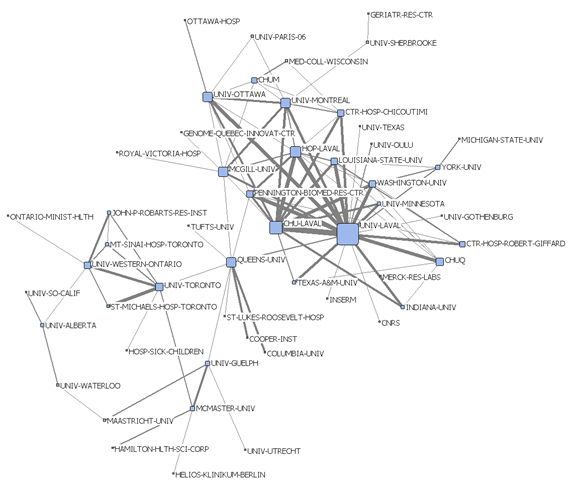
Source: Observatoire des sciences et des technologies, WoS Database
2.4 Specialization
Figure 10 presents a dynamic picture of specialization (SI, x-axis) and impact (ARC, y-axis) in obesity research for G7 countries and CIHR for 1998-2002 and 2003-2007. It visualizes the countries that are both specialized and that have a high impact in obesity research in the upper right quadrant. Although all countries under study obtain ARC values above 1, not all countries are specialized in obesity research. Unsurprisingly, CIHR-funded researchers demonstrate the highest specialization in obesity. However, this specialization decreased between the two 5-year periods, which may be explained either by an increase in non-obesity research papers written by CIHR-funded researchers or by an increase in the world's number of obesity papers. The specialization in obesity research in Canada, Italy and France also decreased between the two periods. Conversely, specialization in obesity research increased for Japan, Germany, the U.K. and the U.S. Over the 10-year period, these three countries, in addition to France, remain less specialized in obesity research than Italy, Canada and the U.S.
Figure 10 - Specialization Index and Average Relative Citations (ARC) for G7 Countries and CIHR in Obesity Research (Core), 1998-2007
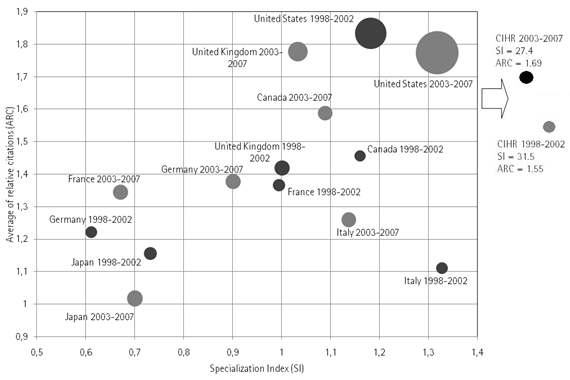
Source: Observatoire des sciences et des technologies, WoS Database
2.5 Obesity Research in a Selection of Canadian and Clinical Journals
2.5.1 Number of Publications
Figure 11, Figure 12 and Table 4 present the annual number of obesity papers published in a selection of Canadian and clinical journals, which represent a subset of core obesity research (see Appendix 1). Given that Canadian journals are overrepresented in this sample, only data for Canada and CIHR-funded researchers are analyzed. Although the percentage of CIHR-funded papers among all Canadian papers decreased between 2006 and 2007, this percentage is above that obtained for the core of obesity research as a whole (68% vs. 52%). This discrepancy suggests that CIHR-funded papers focus on Canadian and clinical aspects of obesity more than other Canadian obesity papers.
Figure 11 - Number of Obesity Papers of CIHR and Canadian Researchers in a Sample of Canadian and Clinical Journals, 1998-2007
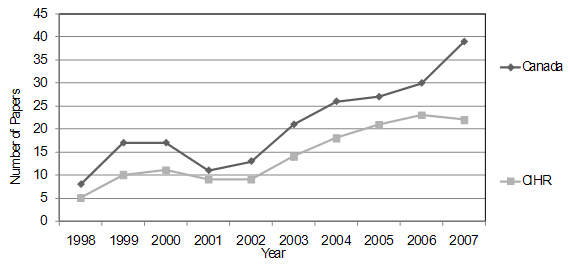
Source: Observatoire des sciences et des technologies, WoS Database
Figure 12 - Share of Obesity Papers of CIHR in Canadian Research in a Sample of Canadian and Clinical Journals, 1998-2007
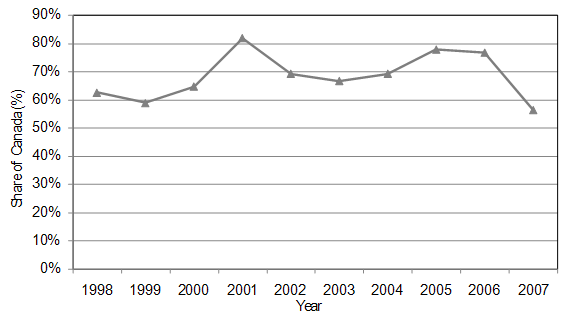
Source: Observatoire des sciences et des technologies, WoS Database
Table 4 - Number of Obesity Papers of CIHR and Canadian Researchers in a Sample of Canadian and Clinical Journals, 1998-2007
| Group | 1998 | 1999 | 2000 | 2001 | 2002 | 2003 | 2004 | 2005 | 2006 | 2007 |
|---|---|---|---|---|---|---|---|---|---|---|
| Canada | 8 | 17 | 17 | 11 | 13 | 21 | 26 | 27 | 30 | 39 |
| CIHR | 5 | 10 | 11 | 9 | 9 | 14 | 18 | 21 | 23 | 22 |
| Canada excluding CIHR |
3 | 7 | 6 | 2 | 4 | 7 | 8 | 6 | 7 | 17 |
Source: Observatoire des sciences et des technologies, WoS Database
2.5.2 Scientific Impact
Figure 13 and Figure 14 present scientific impact measures of this subset of papers. Both ARC (Figure 13) and ARIF (Figure 14) measures are higher for CIHR-funded papers than for Canadian papers (excluding CIHR-funded papers). Although there is not statistically significant difference for the ARC between CIHR and Canadian papers as a whole, there is a slight statistically significant difference when comparing CIHR-funded papers to non-CIHR-funded Canadian papers (p. < 0.1). Similarly, CIHR-funded papers have a significantly higher ARIF (p. < 0.05) than that of non-CIHR- funded Canadian papers. When Canadian papers are included, however, the difference is no longer statistically significant.
Figure 13 - Average of relative citations (ARC) of Obesity Papers of CIHR and Canadian Researchers in a Sample of Canadian and Clinical Journals, 1998-2007
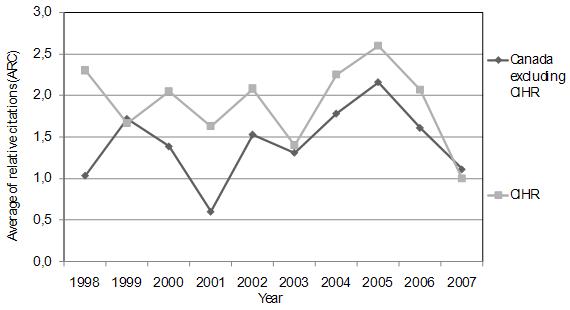
Source: Observatoire des sciences et des technologies, WoS Database
Figure 14 - Average of relative impact factor (ARIF) of Obesity Papers of CIHR and Canadian Researchers in a Sample of Canadian and Clinical Journals, 1998-2007

Source: Observatoire des sciences et des technologies, WoS Database
3 Obesity Research In The Periphery
This last section of the report presents analyses of CIHR-funded research publications in the periphery of obesity by country and their impact. Obesity keywords (Table 1) are searched in the abstract field of papers. In order to minimize the amount of false positives, only publications of four subfields are considered: endocrinology (diabetes), cardiovascular system, nutrition and dietetics, and gastroenterology (including hepatology). The list of journals of each subfield can be found in Appendix 2.
3.1 Number of Publications
Figure 15, Figure 16 and Table 5 show the annual number of obesity papers (periphery) published by G7 countries and by CIHR-funded researchers. One can see that the increase of papers has been less steep than for the whole core of obesity papers. Specifically, the number of periphery obesity papers published all over the world increased from 1,730 to 3,866 between 1998 and 2007, an increase of 223% compared to an increase of 266% for core obesity papers. Unsurprisingly, the U.S. are the most active country, followed by the U.K. As it is the case in the core of obesity papers, Canada ranks last among all countries under study over the whole period. And contrary to what was the case in the core of obesity research, it does not significantly improve its rank over the period. It is notable that CIHR-funded papers in this area have increased 286% over the 10-year period (from 37 to 106 papers). This is a smaller increase than that obtained in the core of obesity research, but is nonetheless the highest among countries in the periphery of obesity research. Table 5 and Table 6 show the number of publications by country in absolute numbers.
Figure 15 - Number of Publications in Obesity (Periphery) for the World, G7 Countries and the U.S., 1998-2007
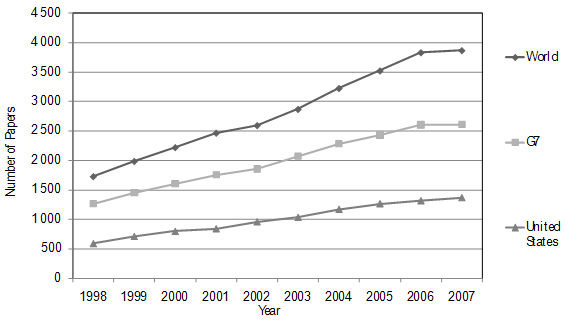
Source: Observatoire des sciences et des technologies, WoS Database
Figure 16 - Number of Publications in Obesity (Periphery) for Specific Countries and CIHR-Funded Researchers, 1998-2007
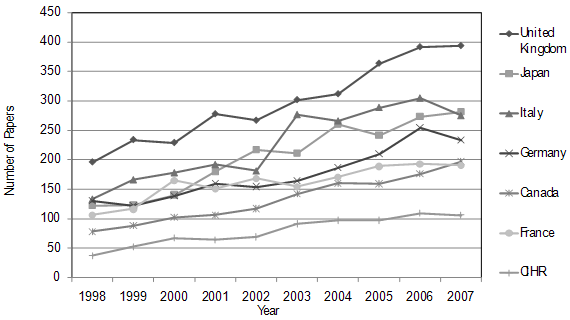
Source: Observatoire des sciences et des technologies, WoS Database
Table 5 - Number of Publications in Obesity (Periphery) for the World, G7 Countries and CIHR-Funded Researchers, 1998-2007
| Country | 1998 | 1999 | 2000 | 2001 | 2002 | 2003 | 2004 | 2005 | 2006 | 2007 |
|---|---|---|---|---|---|---|---|---|---|---|
| Canada | 78 | 88 | 102 | 106 | 117 | 142 | 160 | 159 | 176 | 197 |
| CIHR | 37 | 52 | 67 | 64 | 69 | 91 | 97 | 97 | 109 | 106 |
| France | 106 | 116 | 165 | 151 | 168 | 154 | 171 | 189 | 193 | 191 |
| Germany | 130 | 122 | 138 | 159 | 154 | 164 | 186 | 210 | 254 | 233 |
| Italy | 133 | 166 | 178 | 192 | 181 | 277 | 266 | 289 | 305 | 275 |
| Japan | 122 | 123 | 140 | 180 | 217 | 211 | 260 | 241 | 273 | 281 |
| United Kingdom |
196 | 234 | 229 | 278 | 267 | 302 | 312 | 364 | 392 | 394 |
| United States |
593 | 715 | 799 | 844 | 960 | 1,036 | 1,173 | 1,266 | 1,317 | 1,368 |
| G7 | 1,262 | 1,447 | 1,603 | 1,755 | 1,855 | 2,074 | 2,282 | 2,432 | 2,607 | 2,612 |
| World | 1,730 | 1,988 | 2,222 | 2,467 | 2,596 | 2,870 | 3,225 | 3,522 | 3,830 | 3,866 |
Source: Observatoire des sciences et des technologies, WoS Database
The share of CIHR-funded papers among all Canadian papers (in the periphery of obesity research) remained relatively stable over the period at approximately 59% (Figure 17). This is higher than the percentage of CIHR-funded papers in the core of obesity research (52%). Furthermore, the percentage of Canadian obesity papers (periphery) in G7 increased more or less steadily over the period (contrary to what happened in the core of obesity research), moving from 6.2% in 1998 to 7.6% in 2007 (Figure 18).
Figure 17 - Share of CIHR-Funded Papers in Canadian Obesity Papers (Periphery), 1998-2007

Source: Observatoire des sciences et des technologies, WoS Database
Figure 18 - Share of Canadian Papers in G7 Obesity Papers (Periphery), 1998-2007

Source: Observatoire des sciences et des technologies, WoS Database
3.2 Scientific Impact
Table 6 presents impact measures for CIHR and countries in the periphery of obesity research by subfield. In three out of the four subfields, CIHR's impact is above that of Canada as a whole (ARC is below in gastroenterology and ARIF is below in endocrinology). More specifically, the ARC of CIHR-funded papers (periphery) in endocrinology and its ARIF in cardiovascular system are the highest amongst all countries under study. At the level of subfields, the difference between CIHR and other Canadian papers excluding CIHR-funded papers in ARC is significant in endocrinology (p. < 0.01) and in nutrition and dietetics (p. < 0.05) and the difference in ARIF is significant in cardiovascular system (p. < 0.05) and in nutrition and dietetics (p. < 0.001).
Still at the level of subfields, the ARC difference between CIHR and G7 is significant in cardiovascular system (p. < 0.05) and endocrinology (p. < 0.01) and ARIF differences are significant in cardiovascular system (p. < 0.001), endocrinology (p. < 0.05) and nutrition and dietetics (p. < 0.01). When papers from the United States are excluded from the G7, ARC differences become significant in nutrition and dietetics (p. < 0.05). Because of the sheer number of CIHR-funded papers in gastroenterology, no scientific impact data is significant in this subfield (N.S.: Non-Significant).
When those four specialities are taken together for the whole period, ARC measure of CIHR-funded papers are higher than that of all Canadian papers (p < 0.05) and that of the G7 (p < 0.001). CIHR's ARIF score (1.21) is not significantly different from that of Canada as a whole (1.17), but is well above that of the G7 (1.12; p < 0.001).
Table 6 - Average of Relative Citations (ARC) and Average of Relative Impact Factor (ARIF) of Countries in Obesity Research (Periphery), by Subfield, 1998-2007
| Country | Cardiovascular System |
Endo- crinology |
Gastro- enterology |
Nutrition & Dietetic |
Four Subfields |
|||||
|---|---|---|---|---|---|---|---|---|---|---|
| ARC | ARIF | ARC | ARIF | ARC | ARIF | ARC | ARIF | ARC | ARIF | |
| Canada | 1.48 | 1.24 | 1.49 | 1.11 | 1.17 | 1.12 | 1.39 | 1.32 | 1.45 | 1.17 |
| CIHR | 1.51 | 1.37 | 1.61 | 1.09 | N.S | N.S | 1.51 | 1.49 | 1.57 | 1.21 |
| Other Canada |
1.46 | 1.09 | 1.24 | 1.13 | 1.20 | 1.11 | 1.21 | 1.09 | 1.27 | 1.12 |
| France | 1.00 | 0.91 | 1.28 | 0.99 | 2.75 | 1.60 | 1.24 | 1.14 | 1.29 | 1.03 |
| Germany | 1.31 | 0.98 | 1.44 | 0.99 | 1.22 | 0.97 | 1.01 | 0.93 | 1.34 | 0.98 |
| Italy | 1.08 | 1.02 | 1.11 | 0.95 | 1.83 | 1.20 | 1.20 | 1.18 | 1.17 | 1.01 |
| Japan | 1.34 | 0.92 | 1.16 | 0.91 | 1.47 | 0.92 | 0.73 | 0.83 | 1.18 | 0.91 |
| United Kingdom | 1.73 | 1.25 | 1.49 | 1.09 | 1.56 | 1.35 | 1.29 | 1.18 | 1.49 | 1.15 |
| United States | 1.80 | 1.34 | 1.59 | 1.12 | 2.18 | 1.49 | 1.73 | 1.40 | 1.69 | 1.24 |
| G7 | 1.51 | 1.15 | 1.40 | 1.04 | 1.82 | 1.28 | 1.44 | 1.26 | 1.45 | 1.12 |
| World | 1.34 | 1.08 | 1.26 | 1.01 | 1.67 | 1.18 | 1.28 | 1.17 | 1.30 | 1.06 |
Source: Observatoire des sciences et des technologies, WoS Database
3.3 Specialization
Finally, Table 7 presents specialization indexes for countries in each of the four subfields in the periphery of obesity research. The specialization index is a zero-sum game, which means that a country cannot be specialized in all subfields. Although all countries, with the exception of the U.S., are specialized in the endocrine aspects of obesity, only Italy and Japan are specialized in gastroenterological research in obesity. Non English-speaking countries are specialized in obesity-related cardiovascular research, while English-speaking countries are specialized in preventive aspects of obesity in nutrition and dietetics. CIHR-funded obesity research is highly specialized in endocrinology, and has increased its specialization in cardiovascular system as well as nutrition and dietetics, but is not specialized in gastroenterology.
Table 7 - Specialization Index and Number of Obesity Papers (Periphery) of Countries, by Subfield, 1998-2007
| Country | Cardiovascular System |
Endo- crinology |
Gastro- enterology |
Nutrition & Dietetic |
||||||||
|---|---|---|---|---|---|---|---|---|---|---|---|---|
| 98- 02 |
03- 07 |
Papers | 92- 02 |
03- 07 |
Papers | 98- 02 |
03- 07 |
Papers | 98- 02 |
03- 07 |
Papers | |
| Canada | 0.77 | 0.91 | 217 | 1.06 | 1.07 | 783 | 0.95 | 0.71 | 57 | 1.05 | 1.00 | 268 |
| CIHR | 0.70 | 0.79 | 114 | 1.19 | 1.17 | 516 | 0.18 | 0.09 | 5 | 0.90 | 1.03 | 154 |
| France | 1.12 | 0.91 | 306 | 1.03 | 1.07 | 937 | 0.88 | 1.00 | 83 | 0.83 | 0.91 | 278 |
| Germany | 1.28 | 1.01 | 373 | 1.03 | 1.11 | 1 043 | 0.92 | 0.87 | 85 | 0.68 | 0.74 | 249 |
| Italy | 1.23 | 1.13 | 504 | 1.07 | 1.10 | 1 369 | 1.55 | 1.34 | 176 | 0.46 | 0.48 | 213 |
| Japan | 1.15 | 1.55 | 548 | 1.01 | 0.89 | 1 066 | 1.09 | 1.54 | 162 | 0.80 | 0.59 | 272 |
| United Kingdom |
0.90 | 0.86 | 497 | 1.02 | 1.08 | 1 743 | 0.56 | 0.60 | 96 | 1.13 | 1.04 | 632 |
| United States |
0.93 | 1.02 | 1 896 | 0.98 | 0.97 | 5 439 | 0.88 | 0.98 | 532 | 1.14 | 1.08 | 2 204 |
| G7 | 1.01 | 1.03 | 3 896 | 1.00 | 1.00 | 11 095 | 0.95 | 1.02 | 1 101 | 1.00 | 0.95 | 3 837 |
| World | 1.00 | 1.00 | 5 416 | 1.00 | 1.00 | 15 710 | 1.00 | 1.00 | 1 568 | 1.00 | 1.00 | 5 622 |
Source: Observatoire des sciences et des technologies, WoS Database
Conclusion
This report provides an empirical assessment of Canadian and international research in obesity, with a special emphasis on a group of 303 researchers funded by CIHR for obesity-related research. Two datasets of obesity research were analysed for the period from 1998 to 2007.
The first dataset comprised the core of obesity research, defined as the articles having obesity-related keywords in their abstracts and titles as well as all the papers published in 8 obesity journals. Analysis of this dataset demonstrated that, in terms of number of papers, Canada is at the 7th rank among G7 countries when considering the whole 10-year period, but climbs to the 3rd ranks at the end of this period (2007), behind the U.S. and the U.K., but ahead of Japan, Germany, France and Italy. CIHR-funded researchers account for 52% of Canadian papers in the core of obesity research. The number of papers written by CIHR-funded researchers increased by more 400%, going from 37 in 1998 to 163 in 2007. Along the same lines, the percentage of core obesity papers among all papers authored by researchers funded by CIHR in obesity increased from 10.4% in 2001 to 17.5% in 2007, suggesting that CIHR is increasingly funding researchers for whom obesity is the main research topic. In terms of scientific impact, CIHR-funded obesity papers obtain significantly higher citation rates than other Canadian and G7 obesity papers. International collaboration activities between CIHR-funded researchers are the highest among all countries included in this study. Canadian inter-institutional collaboration is divided into two clusters: the largest of these includes institutions from Québec (Université Laval, Université de Montréal and McGill University) and the smaller revolving around the University of Toronto and McMaster University. Finally, the analysis of a subset of papers published in a selection of Canadian and clinical journals (see Appendix 1) demonstrated that CIHR-funded papers focus more on Canadian and clinical aspects of obesity than non-CIHR-funded Canadian obesity papers.
The second dataset comprised the periphery of obesity research, defined as papers published in four subfields — endocrinology (diabetes), cardiovascular system, nutrition & dietetics and gastroenterology (including liver diseases) — for which at least one obesity-related keyword was found the abstract. As in the core of obesity research, Canada ranks last among all countries under study in the periphery of obesity research. CIHR-funded papers have increased 286% over the 10-year period (from 37 to 106 papers), a smaller increase than for the core of obesity research, but nonetheless the highest among the countries under study. In terms of scientific impact, ARC measures for CIHR-funded papers in the periphery of obesity research are higher than that of all Canadian papers in the same area (p<0.05) as well as for the G7 (p<0.001). Finally, CIHR-funded research on obesity is highly specialized in the subfield of endocrinology, has increased its specialization in the cardiovascular system and nutrition and dietetics subfields, but is not specialized in the subfield of gastroenterology.
Bibliography
Borgatti, S. P., Everett, M. G. & Freeman, L. C. (2002). Ucinet for Windows: Software for Social Network Analysis. Harvard: Analytic Technologies.
Borgatti, S. P. (2002). NetDraw: Graph Visualization Software. Harvard: Analytic Technologies.
Bouchard, C. (2008). How much progress have we made over the last few decades? International Journal of Obesity, 32(S7): S2-S7.
International Association for the Study of Obesity. (2008), International Obesity TaskForce Prevalence Data, Global Obesity Prevalence in Adults. Retrieved 24 March 2009, 7 p.
Jamieson, A. C. (2003). Overweight and Obesity Worldwide now Estimated to Involve 1.7 Billion People, Obesity Surgery, 13(3): 329-330.
Larivière, V., Gingras, Y. & Archambault, E. (2006). Canadian collaboration networks: A comparative analysis of the natural sciences, social sciences and the humanities. Scientometrics, 68(3): 519-533.
Mann, H. B., & Whitney, D. R. (1947). On a test of whether one of two random variables is stochastically larger than the other. Annals of Mathematical Statistics, 18: 50-60.
National Institutes of Health. (1985). Health Implications of Obesity. NIH Consensus Conference Development Statement Online, February. Retrieved 24 March 2009.
Starky, S. (2005). The Obesity Epidemic in Canada, Ottawa, Library of Parliament, document PRB 05-11E, 15 July 2005, 13 p.
Torrance, G. M., Hooper, M. D. & Reeder, B. A. (2002). Trends in overweight and obesity among adults in Canada (1970-1992): Evidence from national surveys using measured height and weight. International Journal of Obesity, 26(6): 797-804.
U.S. Centers for Disease Control and Prevention. (2009). National Center for Chronic Disease Prevention & Health Promotion, Behavioral Risk Factor Surveillance System, Prevalence and Trends Data, Weight Classification by Body Mass Index. Retrieved 24 March 2009, 7 p.
World Health Organization. (1997). Obesity: Preventing and Managing the Global Epidemic. Report of a WHO Consultation, Executive Summary, Geneva, World Health Organization, 3 p.
Appendix 1. Selected Canadian And Other Clinical Journals
American Journal of Clinical Nutrition
American Journal of Medecine
American Journal of Public Health
Atherosclerosis
Canadian Family Physician
Canadian Journal of Cardiology
Canadian Journal of Gastroenterology
Canadian Journal of Public Health – Revue canadienne de santé publique
Canadian Medical Association Journal
Canadian Psychology – Psychologie canadienne
Circulation
Diabetes
Diabetes Care
Diabetologia
Hypertension
Journal of Canadian Studies – Revue d'études canadiennes
Journal of Lipid Research
Public Health Nutrition
Appendix 2. Journals By Subfield
Cardiovascular System
ACP – Applied Cardiopulmonary Pathophysiology
Acta Cardiologica
Advances in Cardiology
Advances in Microcirculation
American Heart Journal
American Journal of Cardiology
American Journal of Geriatric Cardiology
American Journal of Hypertension
American Journal of Noninvasive Cardiology
Angiology
Annales de cardiologie et d'angeiologie
Annals of Noninvasive Electrocardiology
Archiv für Kreislaufforschung
Archives des maladies du coeur et des vaisseaux
Arteriosclerosis
Arteriosclerosis and Thrombosis
Arteriosclerosis, Thrombosis, and Vascular Biology
Artery
Atherosclerosis
Atherosclerosis Reviews
Atherosclerosis Supplements
Basic Research in Cardiology
Blood Pressure
Blood pressure Monitoring
Blood Vessels
British Heart Journal
Canadian Journal of Cardiology
Cardiologia
Cargiology
Cardiology Clinics
Cardiology in the Elderly
Cardiology in the Young
Cardioscience
Cardiovascular Diseases
Cardiovascular Drug Reviews
Cardiovascular Drugs and Therapy
Cardiovascular Medicine
Cardiovascular Pathology
Cardiovascular Research
Cardiovascular Risk Factors
Cardiovascular Toxicology
Catheterization and Cardiovascular Diagnosis
Catheterization and Cardiovascular Interventions
Circulation
Circulation Journal
Circulation Research
Circulatory Shock
Clinical and Applied Thrombosis-Hemostasis
Clinical and Experimental Hypertension
Clinical and Experimental Hypertension Part A – Theory and Practice
Clinical Cardiology
Clinical Research in Cardiology
Coeur
Coeur et médecine interne
Cor et vasa
Coronary Artery Disease
Current Controlled Trials in Cardiovascular Medicine
Current Hypertension Reports
Current Opinion in Cardiology
Current Opinion in Lipidology
Current Problems in Cardiology
Current Vascular Pharmacology
Echocardiography – A Journal of Cardiovascular Ultrasound and Allied Techniques
Europace
European Heart Journal
European Heart Journal Supplements
European Journal of Cardiology
European Journal of Cardio-Thoracic Surgery
European Journal of Cardiovascular Prevention & Rehabilitation
European Journal of Echocardiography
European Journal of Heart Failure
European Journal of Vascular and Endovascular Surgery
European Journal of Vascular Surgery
Geriatric Cardiovascular Medicine
Heart
Heart & Lung
Heart and Vessels
Heart Failure Reviews
Heart Rhythm
Heartweb
Herz
Herz Kreislauf
Hypertension
Hypertension Research
Hypertension Research – Clinical and Experimental
International Angiology
International Heart Journal
International Journal of Cardiac Imaging
International Journal of Cardiology
International Journal of Cardiovascular Imaging
International Journal of Microcirculation – Clinical and Experimental
International Journal of Stroke
Japanese Circulation Journal – English Edition
Japanese Heart Journal
Journal des maladies vasculaires
Journal of Applied Cardiology
Journal of Atherosclerosis and Thrombosis
Journal of Atherosclerosis Research
Journal of Cardiac Failure
Journal of Cardiopulmonary Rehabilitation and Prevention
Journal of Cardiovascular Electrophysiology
Journal of Cardiovascular Medicine
Journal of Cardiovascular Risk
Journal of Clinical Hypertension
Journal of Electrocardiology
Journal of Heart Transplantation
Journal of Heart Valve Disease
Journal of Human Hypertension
Journal of Hypertension
Journal of Interventional Cardiac Electrophysiology
Journal of Interventional Cardiology
Journal of Invasive Cardiology
Journal of Molecular and Cellular Cardiology
Journal of Nuclear Cardiology
Journal of the American College of Cardiology
Journal of the American Society of Echocardiography
Journal of the Renin-Angiotensis-Aldosterone System
Journal of Thrombosis and Thrombolysis
Journal of Vascular Research
Kardiologiya
Microcirculation
Microcirculation Endothelium and Lymphatics
Microcirculation - London
Microcirculation - US
Microvascular Research
Minerva Cardioangiologica
Modern Concepts of Cardiovascular Disease
Nature Clinical Practice Cardiovascular Medicine
Nutrition Metabolism and Cardiovascular Diseases
PACE – Pacing and Clinical Electrophysiology
Paroi Artérielle – Arterial Wall
Pediatric Cardiology
Perfusion
Perfusion - UK
Phlebologie
Progress in Cardiovascular Diseases
Progress in Pediatric Cardiology
Reviews in Cardiovascular Medicine
Revista Espanola de Cardiologia
Texas Heart Institute Journal
Trends in Cardiovascular Medicine
VASA – Journal of Vascular Diseases
Vascular
Vascular Medicine
Zeitschrift füt Kardiologie
Endocrinology
Acta Diabetologica
Acta Diabetologica Latina
Acta Endocrinologica
Advances in Prostaglandin Thromboxane and Leukotriene Research
Annales d'endocrinologie
Baillière's Clinical Endocrinology and Metabolism
Best Practice & Research: Clinical Endocrinology & Metabolism
Bone
Clinical Endocrinology
Clinics in Endocrinology and Metabolism
Comprehensive Endocrinology
Diabetes
Diabetes & Metabolism
Diabetes Care
Diabetes, Nutrition & Metabolism
Diabetes, Obesity & Metabolism
Diabetes Research and Clinical Practice
Diabetes Research: Clinical and Experimental
Diabetes Reviews
Diabetes Technology & Therapeutics
Diabetes/Metabolism Research and Reviews
Diabetes/Metabolism Reviews
Diabetic Medicine
Diabetologia
Endocrine
Endocrine Journal
Endocrine Journal – UK
Endocrine Pathology
Endocrine Research
Endocrine Research Communications
Endocrine Reviews
Endocrinologia Experimentalis
Endocrinologia Japonica
Endocrinologist
Endocrinology
Endocrinology and Metabolism
Endocrinology and Metabolism: Clinics of North America
Endokrinologie
European Journal of Endocrinology
Experimental and Clinical Endocrinology
Experimental and Clinical Endocrinology & Diabetes
Experimental Diabesity Research
Frontiers in Neuroendocrinology
Frontiers of Hormone Research
General and Comparative Endocrinology
Growth Hormone & IGF Research
Growth Regulation
Hormone and Metabolic Research
Hormone Research
International Journal of Obesity
International Journal of Pancreatology
Italian Journal of Mineral & Electrolyte Metabolism
Journal of Clinical Densitometry
Journal of Clinical Endocrinology
Journal of Clinical Endocrinology and Metabolism
Journal of Diabetes and its Complications
Journal of Endocrinological Investigation
Journal of Endocrinology
Journal of Mammary Gland Biology and Neoplasia
Journal of Molecular Endocrinology
Journal of Neuroendocrinology
Journal of Pediatric Endocrinology
Journal of pediatric Endocrinology & Metabolism
Journal of Pineal Research
Journal of Trace Elements in Experimental Medicine
Magnesium Research
Metabolic Bone Disease & Related Research
Metabolism – Clinical and Experimental
Metabolomics
Molecular and Cellular Endocrinology
Molecular Endocrinology
Nature Clinical Practice Endocrinology & Metabolism
Neuroendocrinology
Neuroendocrinology Letters
Obesity
Obesity Research
Obesity Reviews
Pancreas
Pediatric Diabetes
Prostaglandins
Prostaglandins & Other Lipid Mediators
Prostaglandins and Medicine
Prostaglandins Leukotrienes and Essential Fatty Acids
Prostaglandins Leukotrienes and Medicine
Psychoneuroendocrinology
Recent Progress in Hormone Research
Reviews in Endocrine & Metabolic Disorders
Semiconductors and Insulators
Thyroid
Trends in Endocrinology and Metabolism
Vitamins and Hormones – Advances in Research and Applications
Gastroenterology
Acta Gastro – Enterologica Belgica
Alimentary Pharmacology & Therapeutics
American Journal of Digestive Diseases
American Journal of Gastroenterology
Annales de Gastroenterologie et d'hépatologie
Baillière's Clinical Gastroenterology
Best Practice & Research in Clinical Gastroenterology
BMC Gastroenterology
Canadian Journal of Gastroenterology
Clinical Gastroenterology and Hepatology
Clinics in Gastroenterology
Colorectal Disease
Current Opinion in Gastroenterology
Digestion
Digestive and Liver Disease
Digestive Diseases
Digestive Diseases and Sciences
Diseases of the Esophagus
Endoscopy
European Journal of Gastroenterology & Hepatology
Frontiers of Gastrointestinal Research
Gastroenterologia
Gastroenterologia Japonica
Gastroentérologie Clinique et biologique
Gastroenterology
Gastroenterology Clinics of North America
Gastrointestinal Endoscopy
Gut
Helicobacter
Hepato- Gastroenterology
Hepatology
Hepatology Research
Inflammatory Bowel Diseases
International Hepatology Communications
International Journal of Colorectal Disease
Italian Journal of Gastroenterology and Heptaology
Journal of Clinical Gastroenterology
Journal of Diarrhoeal Diseases Research
Journal of Gastroenterology
Journal of Gastroenterology and Hepatology
Journal of Gastrointestinal Motility
Journal of Hepatology
Journal of Viral Hepatitis
Leber Magen Darm
Liver
Liver International
Liver Transplantation
Liver Transplantation and Surgery
Nature Clinical Practice Gastroenterology & Hepatology
Neurogastroenterology and Motility
Pancreatology
Practical Gastroenterology
Progress in Liver Diseases
Rendiconti di Gastro-Enterologia
Reviews in Gastroenterological Disorders
Revista Espanola de Enfermedades Digestivas
Recista Espanola de las Enfermedades des Aparato Digestivo
Scandinavian Journal of Gastroenterology
Seminars in Liver Disease
World Journal of Gastroenterology
Zeitschrift für Gastroenterologie
Nutrition & Dietetics
Acta Alimentaria
Advances in Nutritional Research
Aktuelle Ernahrungsmedizin
American Journal of Clinical Nutrition
Annales de la nutrition et de l'alimentation
Annals of Nutrition and Metabolism
Annual Review of Nutrition
Archivos Latinoamericanos de Nutricion
Asia Pacific Journal of Clinical Nutrition
Baroda Journal of Nutrition
Bibliotheca Nutritio et Dieta
Biological Trace Element Research
British Journal of Nutrition
Cahiers de nutrition et de diététique
Canadian Journal of Dietetic Practice and Research
Clinical Nutrition
Current Opinion in Clinical Nutrition and Metabolic Care
Ecology of Food and Nutrition
Ernahrungs – Umschau
European Journal of Clinical Nutrition
European Journal of Nutrition
Food & Nutrition Notes and Reviews
Food and Nutrition Bulletin
Forum of Nutrition
Growth
Growth Development and Aging
Human Nutrition – Applied Nutrition
Human Nutrition – Clinical Nutrition
Indian Journal of Nutrition and Dietetics
International Journal for Vitamin and Nutrition Research
International Journal of Food Microbiology
International Journal of Food Sciences and Nutrition
International Journal of Sport Nutrition
International Journal of Sport Nutrition and Exercise Metabolism
Journal of Clinical Biochemistry and Nutrition
Journal of Food & Nutrition
Journal of Human Nutrition
Journal of Human Nutrition and Dietetics
Journal of Medicinal Food
Journal of Micronutrient Analysis
Journal of Nutrition
Journal of Nutrition Education
Journal of Nutrition Education and Behavior
Journal of Nutrition Health & Aging
Journal of Nutritional Biochemistry
Journal of Nutritional Science and Vitaminology
Journal of Parenteral and Enteral Nutrition
Journal of the American College of Nutrition
Journal of the American Dietetic Association
Journal of the Canadian Dietetic Association – Revue de l'Association canadienne des diététistes
Nippon Nogeikagaku Kaishi - Journal of the Japan Society for Bioscience, Biotechnology and Agrochemistry
Nutricion Hospitalaria
Nutrition
Nutrition & Metabolism
Nutrition and Metabolism
Nutrition in Clinical Practice
Nutrition International
Nutrition Reports International
Nutrition Research
Nutrition Research Reviews
Nutrition Reviews
Nutrition Today
Nutritional Neuroscience
OCL – Oléagineux, Corps gras, Lipides
Plant Foods for Human Nutrition
Proceedings of the Nutrition Society
Progress in Food and Nutrition Science
Zeitschrift fûr Ernahrungswissenschaft
- Note that these numbers are conservative; the International Obesity Taskforce estimates obesity to affect 32.2% of the people living in the U.S.
- In this report, CIHR includes both INMD and CIHR.
- G7 Countries are G8 countries minus Russia. Russia was removed from the analysis because it publishes virtually no papers in the area of obesity.
- Date modified: